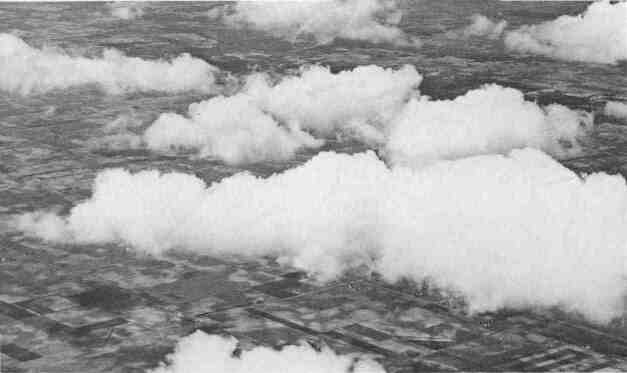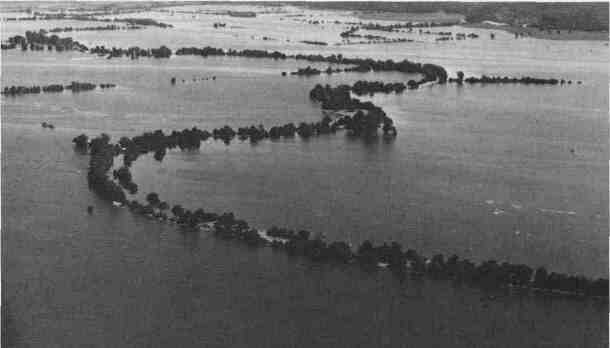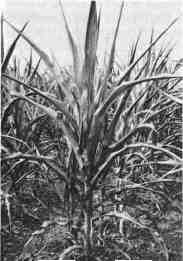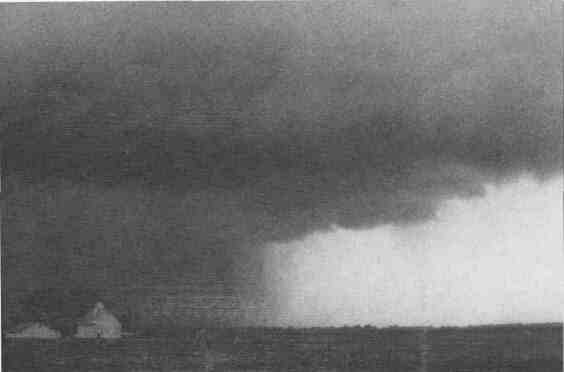Our Natural Resources

Depending on the Climate
by Anne Mueller
While every body talks about the weather,Illinois has launched research to detectchanges in climate.
What is the greenhouse effect?
So-called "greenhouse gases"—carbon dioxide(CO2), methane, nitrous oxide and other trace gases—plus watervapor occur in the atmosphere naturally.These gases are relatively transparent to incoming,short-wave solar radiation, allowing the sun's energy to pass to theearth's surface where some of it is absorbed. Part ofthe stored heat or energy rises back into the atmosphereas long-wave terrestrial radiation, which, unlikeshort-wave radiation, cannot passthrough the greenhouse gases. Consequently, radiant energyis trapped and reflected back to the earth's surface,intensifying its temperature. The effect is like conditions in a greenhouse.
If the greenhouse effect is a naturalprocess, is there anything to be concerned about?
Since the industrial revolution, when the burning of coal boosted CO2emissions, atmospheric concentrations of greenhouse gases have risen 30 percent.Scientific evidence indicates that average global temperatures increased by 0.5to 1.1 degrees Fahrenheit during the 20th century.
While not all scientists agree that these two phenomena are directly related, a strongstatement was made by the international Intergovernmental Panel on Climate Change when, in a draftsummary of findings issued last December, it said: "The warming of the pastcentury and especially the last few years is unlikely to be due to natural causes and a pattern of climaticresponse to human activities is identifiable in the climatological record."
Is this the "global warming" that's been discussed so much lately?
54 * Illinois Parks & Recreation * May/June 1996


It may be surprising to hear that therelationship between CO2 and temperaturechange was first theorized in the1860s. Today, there is uncertainty aboutwhether global warming has begun andthe potential magnitude or timing of anywarming. And climate models, which arerelied on to predict future climatechange, have variable degrees of certainty. Many climate models, however,see as "very probable" the followingconditions:
• global mean surface temperaturewill increase by the mid-21st century;
• global mean precipitation will increase;
• northern hemisphere sea ice will bereduced;
• arctic land areas will have wintertime warming;
• global sea level will rise at an increasing rate.
Instead of "global warming," another term that could be used is "globalclimate change." Whether or not it becomes a reality, some actions are needed.
Why take action?
The floods of 1993 and the heatwave of 1995, for example, revealed thatIllinois and other states are not adequately prepared to deal with crisesbrought about by weather extremes. Inaddition, actions such as employing water conservation measures, changingfloodplain designations, researching newcrop strains and modifying farming techniquescould put Illinois in a better position to deal withclimate extremes when they happen in the future.
What might happen in Illinois?
According to climatologists with theIllinois Department of Natural Resources' State Water Survey, the mostlikely future climate in Illinois would bewarmer and drier than today's, with increasedstorminess also likely. This would lower Lake Michigan and createmajor water problems for Chicago, including the harbors. Agriculture alsowould be affected by the warmer anddrier conditions with lower crop yields.Additional research is needed to betterdefine the potential range of impacts ofa changed climate on human health andactivities, the state's economy and theenvironment.
What actually can be done? Isn't theretruth to the old line about "everybodytalks about the weather, but nobodyever does anything about it"?
Weather is the state of the atmosphere at a given time and place basedon such variables as temperature, precipitation and barometric pressure.Climate is the combination of meteorological conditions that characteristicallyprevail in a particular region over time. By monitoring weather conditions over a
Illinois Parks & Recreation * May/June 1996 * 55



The devastating impact of flooding on the Mississippi and Illinoisrivers in 1993 (above) illustrates the degree of fluctuating weatherpatterns in recent years. Below, the Illinois corn crop withers in theheat of the drought of 1988.
long time span, researchers can measureif and by how much the climate is changing—whetherit's warmer or cooler, drier or wetter. Because earlydetection of the beginning of climate change is importantin making major policy and economicdecisions, Illinois already has launchedresearch to detect the onset of a changein climate.
How do economics come into play?
International pressures are growingfor stricter federal greenhouse gas emissions measures, with industrialized countries expected to soon develop a strategythat would reduce greenhouse gas emissions below their1990 levels by the year 2000. Because Illinois is a major emitterof greenhouse gases, responsible for 5percent of the U.S. total, Illinois wouldface stringent reduction efforts and beplaced at a competitive disadvantageshould federal mandates be adoptedwithout the state's input. Compoundingthe issue is Illinois' unique nuclear profile.Due to its heavy reliance on nuclear facilities to generate electricity, Illinoisactually lowered its greenhouse gasemissions between 1970 and 1990 whenother states were increasing theirs. Stateofficials believe that in helping meet national emissions goals, Illinois should notbe penalized for having an artificiallylow emissions baseline. They want towork toward meeting national goalswhile protecting Illinois interests.
56 * Illinois Parks & Recreation * May/June 1996

So how is Illinois helping shape national policy?
In 1991 the General Assemblyformed the Illinois Task Force on Global Climate Change, composed of statelegislators, state agency directors and private citizens representing business, agriculture, environmental organizations,and academic and scientific institutions.It also identified the State Water Survey,which has collected climate and waterresource data since the turn of the century, as the centerfor research and information about global climate change.
As a first step in establishing a statewide research agenda, the Water Surveydeveloped a Global Climate Change Program and prepared a comprehensive planof research for global climate change issues affecting Illinois. In 1994, the TaskForce on Global Climate Change recommended a plan to track and help formnational climate change policy, reduceor mitigate greenhouse gas emissions,adapt to climate variations, and enhanceresearch on and public awareness aboutclimate change.
Its report, "A Climate Change Action Plan for Illinois," identified severalactivities that could be undertaken tomeet these goals. In January, the taskforce issued another report, "The IllinoisResponse to Climate Change," to document the plan's progress andidentify additional actions to help implement theplan.
What does the plan address?
On one level, the plan advocatesthat policies and programs developed tocut emissions should be flexible, allowing each state to pursue reduction optionsbased on its particular set of circumstances. For example, the plansays forestry programs could be used as practical meansfor removing carbon from theatmosphere. The plan also identifies energy efficiency measures and othervoluntary, socially beneficial and cost-effectiveprograms as functional ways to reducegreenhouse gas emissions. In addition, theplan details appropriate responses to climate change. Because Illinois is among the first to develop a stateplan and implement climate change mitigation pilot projects, it is considered aleader in climate change policy amongthe states.
How is Illinois' Climate Change Action Plan coming along?
Progress has been made in many areas:
• As a result of the task force, Illinois is one of thefirst states to inventory greenhouse gases.A baseline inventory and a report of findings were published in 1993.
• Twelve weather stations havebeen designated as benchmarks to monitorclimate changes for the state. StateWater Survey climatologists will analyzecurrent temperature, precipitation andsnowfall data with historical records todetect the beginning of any climatechange.
• Data compiled by industry,such as crop-hail loss records, are beingcollected to monitor potential meteorologicaltrends in Illinois. A report investigating possible shifts in hailstorms inIllinois has been completed, showing nochange.
• The State Water Survey completed a federally funded study on fourIllinois river basins, analyzing past fluctuations in stream flow,climate conditions and land-use changes.
• As part of the Water Survey'sclimate change plan, existing and proposed studies have been reviewed toidentify areas particularly vulnerable toclimate change so special adaptations canbe determined.
• The Department of Natural Resources' Division of Forest Resourceshas developed a proposal that would increase nursery production and provideincreased technical assistance to privateforest owners and local governments.
• State agencies sponsored aworkshop for landfill operators on a formof cogeneration—capturing methane atlandfills to produce electricity.
• As part of a pilot project to determine thecost-effectiveness of working with other countriesto reduce greenhouse gas emissions, the Department ofNatural Resources conducted and evaluated a joint implementation programwith two Chinese provinces in need ofrepairing leaking gas pipelines. Theproject developed a feasibility study forrepairing the gas lines and indicated asignificant potential for establishing cooperative cogeneration and methaneemission projects. In light of the state'snuclear profile, Illinois is advocating afederal policy that would treat emissionsreductions achieved through international joint implementation the same asreductions achieved at home.
• Several long-term projects havebeen established to disseminate information about global climate change and itseffects on Illinois. These include incorporating climate change issues in gradeschool and high school science coursesas part of Project Environmental Literacy2000 and providing teaching materialsand class projects for specific environmental issues through Project Plan-It.The Water Survey's Global ClimateChange Program has generated a seriesof publications discussing various aspects of climate change for use in schoolsand by the general the public.
What still needs to be done?
Although much has been accomplished, more projects are in the works:
• A review is underway of Illinois water laws and the laws of otherstates to determine effective action in acrisis. When the study is completed, legislation will beprepared to modify water laws.
Illinois Parks & Recreation * May/June 1996 * 57


A mid-summer rain storm approaches an Illinois farmstead.
• Floodplain boundaries willcontinue to be periodically reviewed aspart of the National Flood Insurance Program so development can be managedunder changed climate conditions.
• Research needs to be conductedon crops, crop strains and farming techniques to keep Illinois agricultureprofitable under changing climate situations.
• Landfills will be selected toparticipate in pilot projects to reducemethane emissions.
• This fall, a climate conferencewill be organized for Illinois' researchscientists and for representatives of stateagencies and the private sector, and astate research agenda will be developedbased on conference findings.
• The Department of Natural Resources will inventory thewater conservation measures used in northeastern Illinois as a guide for other parts of the state.
• The Department will identifyrules for constructing water systems,sewers and other types of infrastructurein which climate change must be takeninto account.
How can copies of the task force reports be obtained?
For copies of "A Climate ChangeAction Plan for Illinois" (1994) or "TheIllinois Response to Climate Change" (1996),contact the Department of Natural Resources' Clearinghouseat 217/782-7498. The Department's TDD number for the hearing impairedis 217/782-9175.
Anne Mueller is a staff writer for Outdoor Illinois. Photos for thisstory courtesy of the Illinois State Water Survey
58 * Illinois Parks & Recreation * May/June 1996









